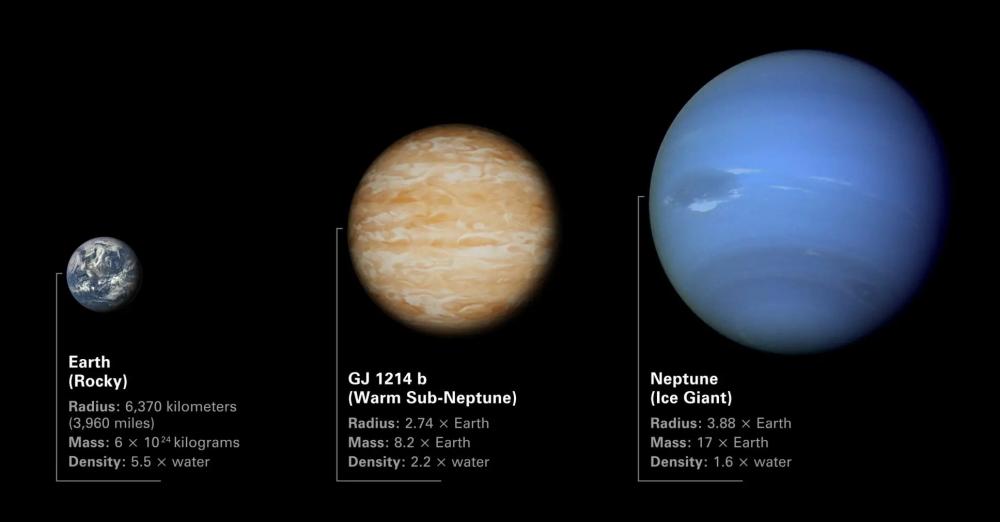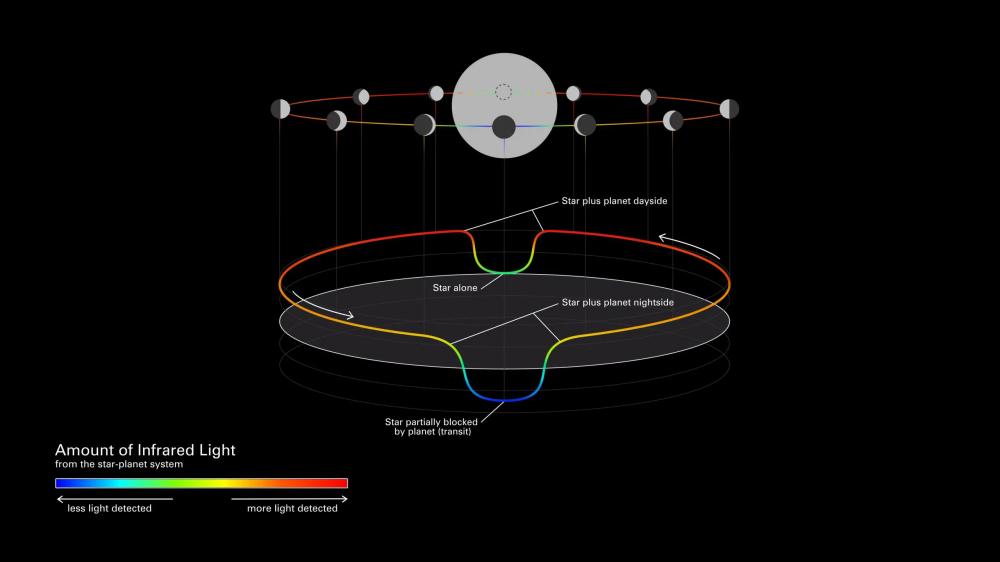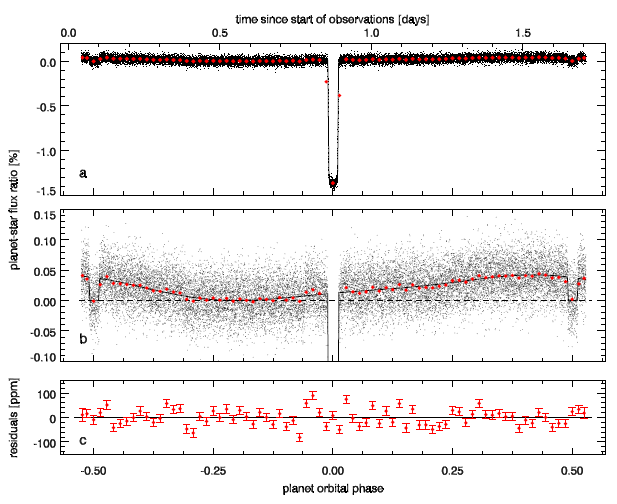
Figure1 - Illustration comparing the sub-Neptune exoplanet GJ 1214 b with Earth and Neptune, which lies between the two planets in terms of radius, mass and density.
Credit: NASA, ESA, CSA and D. Player (STScI)
Discovered in 2009, exoplanet GJ1214b orbits a small star just 40 light-years away. With a mass around six times that of Earth and an atmosphere made up of hydrogen and helium, it is considered a "mini-Neptune".
A team from NASA, in collaboration with researchers from CEA Paris-Saclay, pointed the JWST at the planet using the MIRI instrument, built by CEA Paris-Saclay, for some 40 hours. This unprecedented observation made it possible to obtain, for the first time, the phase curve of an exoplanet with MIRI, i.e. complete tracking of the planet's rotation around its star.
By following the evolution of the exoplanet-star system's emission, the research team was able to determine the planet's temperature to within 9°: 280°C on the dayside and 164°C on the night side. Comparing the observations with atmospheric models, the researchers deduce that: 1. the small temperature difference between the two sides, despite the planet's synchronous rotation, means that there is a good exchange of energy between the sides, due to a dense atmosphere. 2. The relatively low temperature on the dayside, given the planet's proximity to its star, indicates that a layer of aerosols in the exoplanet’s upper atmosphere reflects much of the stellar radiation. The type of aerosol with such a property has yet to be determined. 3. The atmosphere contains many elements heavier than hydrogen and helium, probably abundant water.
The results are published in the prestigious journal Nature
GJ1214b is a very interesting exoplanet for several reasons:
- It belongs to a class of exoplanets for which we have no equivalent in the solar system: mini-Neptunes (8M⊕ et 2.7R⊕), which are very numerous in our galaxy;
- It is very close to its star, completing a full circle in 37.9 hours;
- It rotates synchronously, which means that it rotates on itself while it rotates around its star. It therefore always presents the same face to the star. As a result, there is a dayside heated by the star and a night side. An example of synchronous rotation close to us is the Moon, which rotates on itself as it circles the Earth, so that it is always the same side of the Moon that is seen from the Earth.
- It is "transiting", meaning that we can observe its passage in front of the star from Earth. When it passes in front of its star (transit), its night side faces us. As its orbit is circular, we can also observe its "disappearance" behind the star (eclipse), just before and after the eclipse, its dayside that faces us. What's more, we can follow the evolution of the exoplanet-star system's emission as a function of the exoplanet's position in its orbit (see Figure 2). The curve describing the evolution of the signal as a function of time is called the phase curve.

Figure 2 - Simplified diagram of an exoplanet phase curve, the change in total brightness of a stellar system and its planets as the planet orbits the star. The system appears brighter as more of the planet's illuminated side faces the telescope (full phase), and becomes darker as the dark side faces the telescope (new phase).
Credit: NASA, ESA, CSA, Danny Player (STScI)

Figure 3 - White-light phase curve of GJ1214b obtained with the JWST MIRIm instrument.
a. Integrated 5-12 µm phase curve. Transit and two eclipses are clearly visible at orbital phases 0.0 and ±0.5 respectively. Black dots represent data and red dots represent data averaged per 5-degree segment. The black line is the best-fit model.
b. Same as panel a, but zoomed in on the phase modulation of the planet's thermal emission. The dotted black line indicates the stellar flux (assumed constant) in the absence of any emission from the planet.
c. Residuals of binned astrophysical model data with error bars at 1 ?.
Credit: https://arxiv.org/abs/2305.06240
To better understand the nature of this object, it is important to characterize its atmosphere. Initial observations with the Hubble Space Telescope revealed a layer of aerosols at high altitude, making it impossible to see what's going on below.
To further characterize this atmosphere, the JWST's MIRI instrument was the ideal choice for two reasons:
- the infrared light detected by MIRI has the property of being able to penetrate clouds
- given the expected temperature (around 300°C), most of the light emitted by the exoplanet is in the infrared range detected by MIRI.
The JWST was pointed at the GJ1214 system for around 40 hours, slightly longer than the time it takes for the exoplanet to orbit its star. The low spectral resolution mode of the MIRIm imager on the MIRI instrument, built at CEA Paris-Saclay, was used. Figure 3 shows the resulting phase curve. This is the longest continuous observation of an exoplanet to date with the JWST, and the first phase curve with the JWST MIRI instrument. The JWST's remarkable stability on this time scale makes such a feat possible.
The daytime temperature was determined to be 280°C with very good accuracy (9°), as was the night-time temperature: 164°C. The planet is heated by the light energy it receives from the star on its dayside. The relatively small difference in temperature between the day and night sides shows that there is a good exchange of energy between the two sides, thanks to the planet's atmosphere.
An energy balance for GJ1214b was drawn up between the light energy received from its star and the light energy emitted by the exoplanet. From this balance, it could be shown that a large part of the star's light was reflected by the aerosol layer in the exoplanet's upper atmosphere, and did not contribute to the exoplanet's heating. The type of aerosol with such a property has yet to be determined.
Another important piece of information obtained by comparing observations with models that calculate atmospheric emission is that the atmosphere contains many elements heavier than hydrogen and helium, and probably abundant water. Further studies are needed to refine the results. However, it is fascinating to see that, thanks to the JWST and MIRI in particular, we can go and "check out" worlds so far removed from those we know in our solar system.
Contacts DAp: Elsa Ducrot, Achrene DYREK, Pierre-Olivier Lagage
• Structure and evolution of the Universe › Planets, star's formation and dynamics, interstellar medium
• Department of Astrophysics (DAp) // UMR AIM
• Laboratory Dynamics of Stars, Exoplanets and their Environment
• JWST



